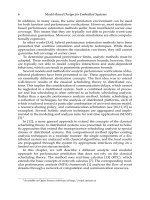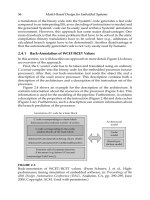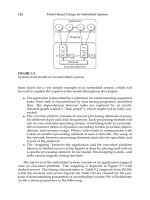CMP book embedded systems design - Preface
Bạn đang xem bản rút gọn của tài liệu. Xem và tải ngay bản đầy đủ của tài liệu tại đây (101.27 KB, 4 trang )
Preface
Why write a book about designing embedded systems? Because my experiences
working in the industry and, more recently, working with students have convinced
me that there is a need for such a book.
For example, a few years ago, I was the Development Tools Marketing Manager for
a semiconductor manufacturer. I was speaking with the Software Development
Tools Manager at our major account. My job was to help convince the customer
that they should be using our RISC processor in their laser printers. Since I owned
the tool chain issues, I had to address his specific issues before we could convince
him that we had the appropriate support for his design team.
Since we didn’t have an In-Circuit Emulator for this processor, we found it
necessary to create an extended support matrix, built around a ROM emulator,
JTAG port, and a logic analyzer. After explaining all this to him, he just shook his
head. I knew I was in trouble. He told me that, of course, he needed all this stuff.
However, what he really needed was training. The R&D Group had no trouble
hiring all the freshly minted software engineers they needed right out of college.
Finding a new engineer who knew anything about software development outside of
Wintel or UNIX was quite another matter. Thus was born the idea that perhaps
there is some need for a different slant on embedded system design.
Recently I’ve been teaching an introductory course at the University of
Washington-Bothell (UWB). For now, I’m teaching an introduction to embedded
systems. Later, there’ll be a lab course. Eventually this course will grow into a full
track, allowing students to earn a specialty in embedded systems. Much of this
book’s content is an outgrowth of my work at UWB. Feedback from my students
about the course and its content has influenced the slant of the book. My
interactions with these students and with other faculty have only reinforced my
belief that we need such a book.
What is this book about?
This book is not intended to be a text in software design, or even embedded
software design (although it will, of necessity, discuss some code and coding
issues). Most of my students are much better at writing code in C++ and Java
than am I. Thus, my first admission is that I’m not going to attempt to teach
software methodologies. What I will teach is the how of software development in
an embedded environment. I wrote this book to help an embedded software
developer understand the issues that make embedded software development
different from host-based software design. In other words, what do you do when
there is no printf() or malloc()?
Because this is a book about designing embedded systems, I will discuss design
issues — but I’ll focus on those that aren’t encountered in application design. One
of the most significant of these issues is processor selection. One of my
responsibilities as the Embedded Tools Marketing Manager was to help convince
engineers and their managers to use our processors. What are the issues that
surround the choice of the right processor for any given application? Since most
new engineers usually only have architectural knowledge of the Pentium-class, or
SPARC processors, it would be helpful for them to broaden their processor horizon.
The correct processor choice can be a “bet the company” decision. I was there in a
few cases where it was such a decision, and the company lost the bet.
Why should you buy this book?
If you are one of my students.
If you’re in my class at UWB, then you’ll probably buy the book because it is on
your required reading list. Besides, an autographed copy of the book might be
valuable a few years from now (said with a smile). However, the real reason is that
it will simplify note-taking. The content is reasonably faithful to the 400 or so
lectures slides that you’ll have to sit through in class. Seriously, though, reading
this book will help you to get a grasp of the issues that embedded system
designers must deal with on a daily basis. Knowing something about embedded
systems will be a big help when you become a member of the next group and start
looking for a job!
If you are a student elsewhere or a recent graduate.
Even if you aren’t studying embedded systems at UWB, reading this book can be
important to your future career. Embedded systems is one of the largest and
fastest growing specialties in the industry, but the number of recent graduates
who have embedded experience is woefully small. Any prior knowledge of the field
will make you stand out from other job applicants.
As a hiring manager, when interviewing job applicants I would often “tune out” the
candidates who gave the standard, “I’m flexible, I’ll do anything” answer. However,
once in while someone would say, “I used your stuff in school, and boy, was it ever
a kludge. Why did you set up the trace spec menu that way?” That was the
candidate I wanted to hire. If your only benefit from reading this book is that you
learn some jargon that helps you make a better impression at your next job
interview, then reading it was probably worth your the time invested.
If you are a working engineer or developer.
If you are an experienced software developer this book will help you to see the big
picture. If it’s not in your nature to care about the big picture, you may be asking:
“why do I need to see the big picture? I’m a software designer. I’m only concerned
with technical issues. Let the marketing-types and managers worry about ‘the big
picture.’ I’ll take a good Quick Sort algorithm anytime.” Well, the reality is that, as
a developer, you are at the bottom of the food chain when it comes to making
certain critical decisions, but you are at the top of the blame list when the project
is late. I know from experience. I spent many long hours in the lab trying to
compensate for a bad decision made by someone else earlier in the project’s
lifecycle. I remember many times when I wasn’t at my daughter’s recitals because
I was fixing code. Don’t let someone else stick you with the dog! This book will
help you recognize and explain the critical importance of certain early decisions. It
will equip you to influence the decisions that directly impact your success. You owe
it to yourself.
If you are a manager.
Having just maligned managers and marketers, I’m now going to take that all back
and say that this book is also for them. If you are a manager and want your
project to go smoothly and your product to get to market on time, then this book
can warn you about land mines and roadblocks. Will it guarantee success? No, but
like chicken soup, it can’t hurt.
I’ll also try to share ideas that have worked for me as a manager. For example,
when I was an R&D Project Manager I used a simple “trick” to help to form my
project team and focus our efforts. Before we even started the product definition
phase I would get some foam-core poster board and build a box with it. The box
had the approximate shape of the product. Then I drew a generic front panel and
pasted it on the front of the box. The front panel had the project’s code name, like
Gerbil, or some other mildly humorous name, prominently displayed. Suddenly, we
had a tangible prototype “image” of the product. We could see it. It got us focused.
Next, I held a pot-luck dinner at my house for the project team and their
significant others.
[2]
These simple devices helped me to bring the team’s focus to
the project that lay ahead. It also helped to form the “extended support team” so
that when the need arose to call for a 60 or 80 hours workweek, the home front
support was there.
(While that extended support is important, managers should not abuse it. As an
R&D Manager I realized that I had a large influence over the engineer’s personal
lives. I could impact their salaries with large raises and I could seriously strain a
marriage by firing them. Therefore, I took my responsibility for delivering the right
product, on time, very seriously. You should too.)
Embedded designers and managers shouldn’t have to make the same mistakes
over and over. I hope that this book will expose you to some of the best practices
that I’ve learned over the years. Since embedded system design seems to lie in
the netherworld between Electrical Engineering and Computer Science, some of
the methods and tools that I’ve learned and developed don’t seem to rise to the
surface in books with a homogeneous focus.
[2]
I can't take credit for this idea. I learned if from Controlling Software Projects, by
Tom DeMarco (Yourdon Press, 1982), and from a videotape series of his lectures.
How is the book structured?
For the most part, the text will follow the classic embedded processor lifecycle
model. This model has served the needs of marketing engineers and field sales
engineers for many years. The good news is that this model is a fairly accurate
representation of how embedded systems are developed. While no simple model
truly captures all of the subtleties of the embedded development process,
representing it as a parallel development of hardware and software, followed by an
integration step, seems to capture the essence of the process.
What do I expect you to know?
Primarily, I assume you are familiar with the vocabulary of application
development. While some familiarity with C, assembly, and basic digital circuits is
helpful, it’s not necessary. The few sections that describe specific C coding
techniques aren’t essential to the rest of the book and should be accessible to
almost any programmer. Similarly, you won’t need to be an expert assembly
language programmer to understand the point of the examples that are presented
in Motorola 68000 assembly language. If you have enough logic background to
understand ANDs and ORs, you are prepared for the circuit content. In short,
anyone who’s had a few college-level programming courses, or equivalent
experience, should be comfortable with the content.
Acknowledgments
I’d like to thank some people who helped, directly and indirectly, to make this
book a reality. Perry Keller first turned me on to the fun and power of the in-circuit
emulator. I’m forever in his debt. Stan Bowlin was the best emulator designer that
I ever had the privilege to manage. I learned a lot about how it all works from
Stan. Daniel Mann, an AMD Fellow, helped me to understand how all the pieces fit
together.
The manuscript was edited by Robert Ward, Julie McNamee, Rita Sooby, Michelle
O’Neal, and Catherine Janzen. Justin Fulmer redid many of my graphics. Rita
Sooby and Michelle O’Neal typeset the final result. Finally, Robert Ward and my
friend and colleague, Sid Maxwell, reviewed the manuscript for technical accuracy.
Thank you all.
Arnold Berger
Sammamish, Washington
September 27, 2001









